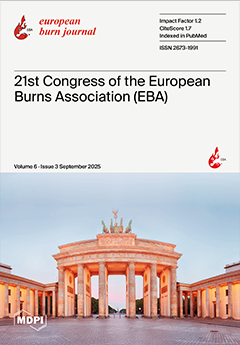Background: Severe burn injuries often lead to lasting physical and psychological consequences. Post-traumatic stress disorder (PTSD) is common among burn survivors and may be influenced by persistent somatic complaints. This study examined whether PTSD is associated with a higher burden of physical symptoms during and after inpatient rehabilitation. Methods: We conducted a subgroup analysis of a multicenter prospective cohort study involving 103 adult burn patients in inpatient rehabilitation. Based on Impact of Event Scale—Revised (IES-R) scores and clinical evaluation, patients were grouped as PTSD (n = 43) or No PTSD (n = 60). Physical symptoms assessed included skin dryness (xerosis), temperature sensitivity (cold/heat), numbness, skin tightness, and increased sweating. Results: Patients with PTSD reported significantly more physical symptoms at follow-up than those without PTSD: xerosis (74% vs. 50%,
p = 0.03), cold sensitivity (61% vs. 35%,
p = 0.02), heat sensitivity (63% vs. 39%,
p = 0.03), numbness (63% vs. 33%,
p = 0.006), skin tightness (82% vs. 52%,
p = 0.004), and sweating (45% vs. 19%,
p = 0.01). PTSD patients also had more severe burns, reflected in higher full-thickness TBSA (2% vs. 0%,
p = 0.03) and elevated ABSI scores (median 6 vs. 5,
p = 0.04). Conclusion: PTSD is associated with a higher and more persistent burden of physical skin symptoms after severe burns. These findings underscore the importance of early PTSD screening and integrated psychological-somatic rehabilitation to improve long-term recovery and quality of life.
Full article






